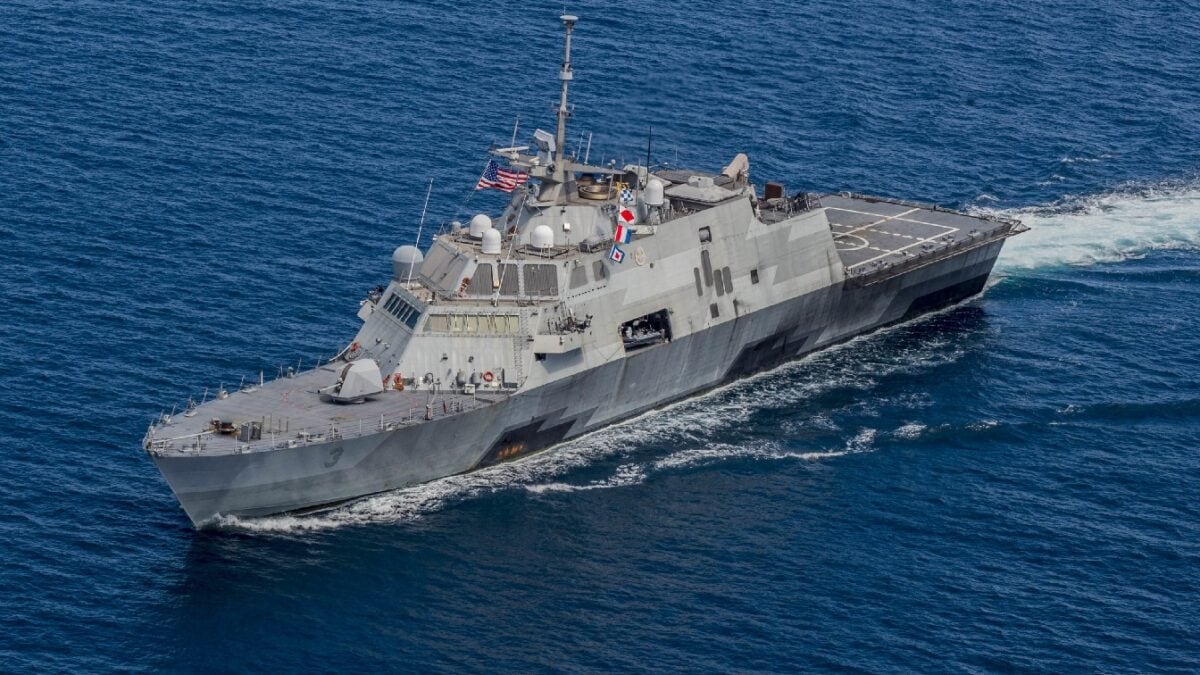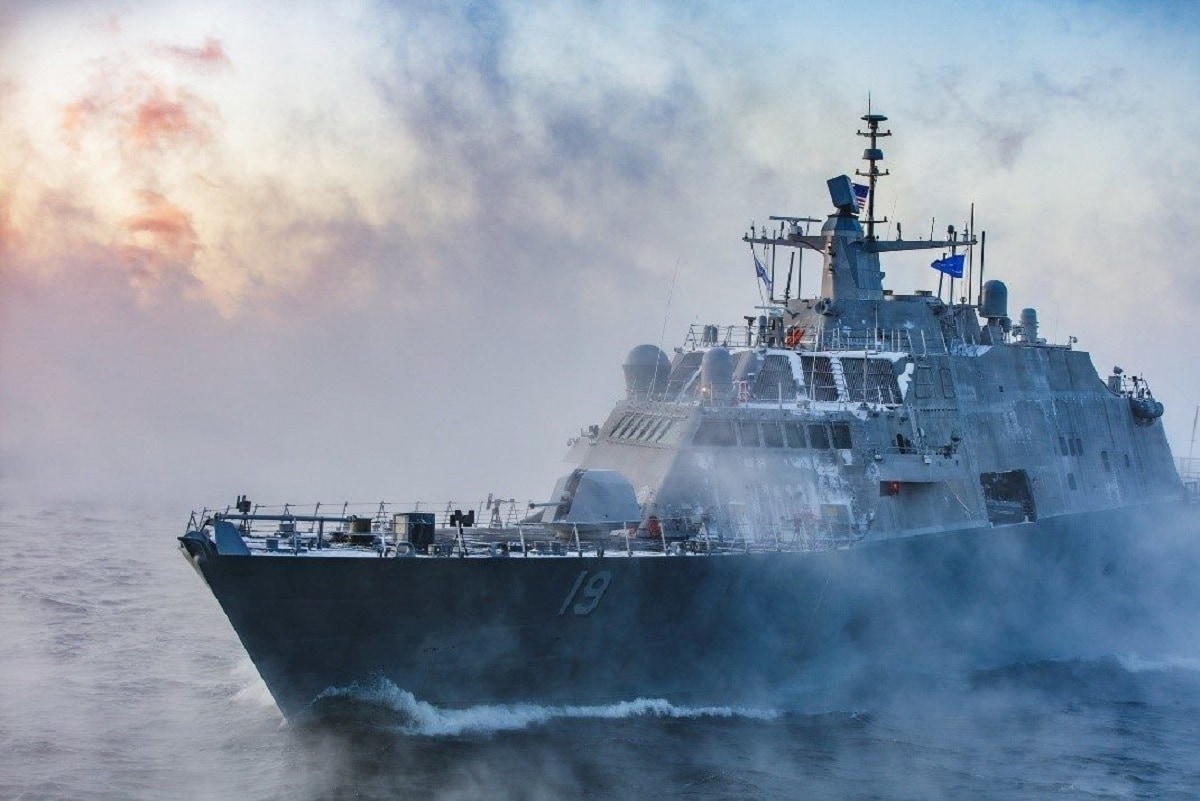As so often, Admiral Jim Stavridis called it right. Of this week’s decommissioning of USS Sioux City, a Freedom-class littoral combat ship (LCS), after less than five years’ service, the retired NATO supreme allied commander and Fletcher School dean declared: “Hard to figure this one out . . . . Hate to see anything decommissioned when we are so far behind China in overall ship count.”
Yes. It is a head-scratcher.
The retirement of Sioux City and the Aegis cruiser Mobile Bay the week before left the U.S. Navy’s tally at 297 ships of war, to around 340 for China’s People’s Liberation Army Navy. And that deficit vis-à-vis China is only set to widen as American shipbuilding dawdles while China gallops ahead. The U.S. Navy needs new hulls displacing water. And it needs to find ways to wring value from the assets it already has—especially from new assets like Sioux City that have plenty of service life left.
Sioux City did need a repair to its “combining gear,” which yoked its diesel and gas-turbine engines to the drive train for maximum speed. This has been a class-wide problem. But the fix was only going to cost the navy $4-5 million and was slated for an upcoming yard period. (It’s not entirely clear from press reports whether the work was completed before decommissioning. It appears not.) In any event, Sioux City’s material condition wasn’t the reason given for retiring the ship. Accounts vary, but the navy leadership and Congress have seemingly come to believe that littoral combat ships cannot defend themselves in high-intensity combat, and that they dish out too feeble a combat punch to justify keeping them in the inventory.
Their verdict: the return on investment isn’t there unless the LCS qualifies as a frontline combatant. Fleet action is the only standard to measure its worth. But that’s not necessarily the case, is it? Now, I am neither a booster nor a basher of the littoral combat ship. My take on the program remains what it was a decade or so ago, when an editor first asked me to say something about it. Namely that we have these hulls now, and that we can find use for them if we exercise some imagination.
Whether we should have acquired them in their current guise is another question. LCS detractors are correct to depict the process of designing and fielding these vessels as tantamount to malpractice. Shipbuilders and navy magnates premised their design on a slew of claims that were not only not self-evident but flat wrong, such as that a “mission module”—basically the ship’s suite of sensors and armaments—could be changed out in a hurry, repurposing this single-mission ship in the midst of a sea fight. Or that a crew of forty was sufficient for a ship that displaced as much as a light frigate. Or that the crew could get by without maintaining its own equipment, trusting to contractors to do repairs and upkeep in port. And on and on.
These were all intriguing and reasonable-sounding hypotheses at the time. But rather than build a few littoral combat ships and experiment with them at sea to validate, falsify, or amend the concept, the navy bypassed the experimental phase and ordered the ships into mass production. The automotive equivalent would be ordering a concept car into production without taking it out on the road for a spin. No manager would survive such a foreseeably catastrophic decision.
You know what they say about assumptions. Taking something false for granted can lead you down a dreary path.
And yet something bugs me about the service’s attitude toward the LCS program. It’s bipolar. For many years naval officialdom defended the program against all comers, insisting the vessels would pay off. Now it has lurched to the opposite extreme, insisting that high-intensity battle represents the only standard of adequacy for a warship, that the LCS falls short in offensive and defensive warfare, and thus that the LCS contingent should be discarded. QED.
By that logic the navy should scrap all of them except whatever it needs for minesweeping.
Two points. One, as a general rule ships do not fight alone. They fight as part of a fleet and, assuming the battle takes place within reach of shore-based assets, as part of a joint force vying for command of the sea. Joint forces fight joint forces. And yet oftentimes the commentary over this or that platform seems to assume it will be thrown into the teeth of enemy firepower without support from the rest of the composite force. The idea seems to be that matching an individual platform’s capabilities against the worst an opponent can hurl against it lets you render a sound judgment of its fitness.
Aviation commentators are famous for this. How often have you heard proponents of stealth aircraft imply, or say outright, that non-stealthy planes like the A-10 Warthog should be retired because they can’t stand up against modern integrated air defenses? Well, that might be apt criticism if the air force as a whole can’t perform its function, suppressing enemy air defenses so attack planes like the A-10 can do their work in relatively safe skies. Seldom are debates over airframes that holistic, though. There’s an abstract, unreal quality to them.
Same with LCS. One hopes lawmakers have insisted that the sea service conduct wargaming involving fleets and joint forces, simulating real-world operations, rather than letting service representatives just recite technical specifications about sensors and weaponry and pronounce the LCS unfit for battle duty. If the navy is serious about distributed maritime operations, its core concept of recent years, it must accept that not every warship in the surface force is going to be a multi-mission warship like a guided-missile cruiser or destroyer. In fact, distributed maritime operations envisions fielding swarms of smaller, low-end combatants able to fan out in near-shore zones, chiefly among Pacific islands, to deny an antagonist maritime command until such time as U.S. and allied forces can win command for themselves.
In other words, distributed maritime operations do not depend entirely—or even mostly—on capital ships. Lighter combatants are essential to them.
For instance: if senior commanders ordered the U.S. Navy, Marine Corps, and Air Force to close Asia’s first island chain to hostile passage in wartime, as they well might, light surface craft, minelayers, tactical warplanes, and submarines would constitute the platforms of choice in waters along the island chain. Lower-end craft can close a strait to Chinese seaward movement. Meanwhile heavy combatants would roam the Western Pacific east of the island chain, helping stifle any Chinese breakouts while providing cover for lighter forces operating closer in. Littoral combat ships would fit into this scheme alongside heavy battle-force ships.
If it hasn’t already done so, Congress should demand that wargames be held to test out distributed operations merging low- with high-end assets. In all likelihood such trials would demonstrate that the LCS has a part to play in the fights most likely to take place.
And two, service chieftains would profit from reviewing the basics of how to constitute a fleet. A century-plus ago historian Julian S. Corbett explained that no navy can be made up entirely of capital ships. Heavy hitters make up the battle fleet, which goes up against enemy battle fleets in the struggle for command. They shoulder the brunt of combat, so they’re indispensable. But they’re too pricey, specialized, and resource-intensive to buy in bulk. That being the case, a navy needs large numbers of lesser combatants—Corbett calls them “cruisers” and the “flotilla”—to police the sea lanes once command is in hand and the brine is relatively safe, and to perform the multitude of errands that navies must perform apart from fleet engagements. Smaller vessels are cheaper, they’re lightly armed but adequately armed for less-intense missions, and they are affordable in large numbers. Adequacy and numbers are their virtue. A navy cannot do without them.
It would be worth rediscovering Corbett’s logic of fleet design rather than—in effect—insisting that all U.S. Navy ships must be capital ships fit to join the line of battle. It may be that the fleet could use some rebalancing to conform to current operational concepts and the naval wisdom of yore. In which case disposing of the LCS contingent would be a mistake.
To keep this article from sprawling out of control lengthwise, consider just one scenario for LCS operations beneath the threshold of armed conflict. Great-power competition is all the rage in policy and strategy nowadays. That means peacetime strategic competition in theaters such as the South China Sea, where successive U.S. presidential administrations have vowed to uphold the law of the sea in the face of Chinese depredations. Joint coast-guard patrols are reportedly preparing to take to the sea later this year. That’s good. But no coast-guard patrol can stand up to China’s navy should Chinese Communist Party leaders dispatch warships to the scene of a confrontation at, say, Scarborough Shoal or Second Thomas Shoal. Coast-guard cutters will need military backup in times of crisis.

(Aug. 19, 2015) The littoral combat ship USS Fort Worth (LCS 3) assembles in formation with ships from the Royal Malaysian Navy as part of Cooperation Afloat Readiness and Training (CARAT) Malaysia 2015. CARAT is an annual, bilateral exercise series with the U.S. Navy, U.S. Marine Corps and the armed forces of nine partner nations. (U.S. Navy photo by Mass Communication Specialist 2nd Class Joe Bishop/Released)
It does no good to pretend the China challenge is a purely law-enforcement challenge. This is a state challenger deploying irregular and regular means to overthrow the regional order at sea. Those are the terms on which the competition will be waged.
That being the case, a layered, supple counterstrategy is in order. Light U.S. Navy combatants, not cruisers, destroyers, or carriers, should be the option of first resort to furnish the necessary backup for coast-guard efforts. A littoral combat ship, outfitted with a surface-warfare mission module complete with heavy-hitting naval strike missiles, would outgun any China Coast Guard cutter or maritime militia boat. Beijing would be forced to send gray hulls to the scene to restore local superiority and reinforce its claims to sovereignty. In so doing it would remind everyone—once again—who’s the bully in Southeast Asia.
Involving the PLA Navy would also belie the narrative that the China Coast Guard is merely policing sovereign waters that have belonged to China by right since antiquity, and guarding Chinese vessels engaged in lawful commercial activity. Ultimately—especially if the U.S. Navy upped the ante by stationing brawnier combatants of its own in regional waters—Beijing might well balk at further escalation. If it relented, uneasy peace would resume. If it flung the dice anyway, escalating to armed force, it would reveal itself to be an aggressor preying on its neighbors in defiance of international law. That’s a reputation party leaders ardently want to avoid. And escalation would set in motion consequences no party leader could relish.

Littoral Combat Ship. Image Credit: Creative Commons.
There’s already some evidence that using littoral combat ships in this manner yields strategic advantage in the gray zone. Using them to thrust Beijing onto the horns of a dilemma has been tried.
That Stavridis guy is no dummy. We should listen to him—and refuse to blithely throw away hulls that could come in handy.
Author Expertise
Dr. James Holmes is J. C. Wylie Chair of Maritime Strategy at the U.S. Naval War College and a Distinguished Fellow at the Brute Krulak Center for Innovation & Future Warfare, Marine Corps University. The views voiced here are his alone. This author is a Contributing Editor for 19FortyFive.

